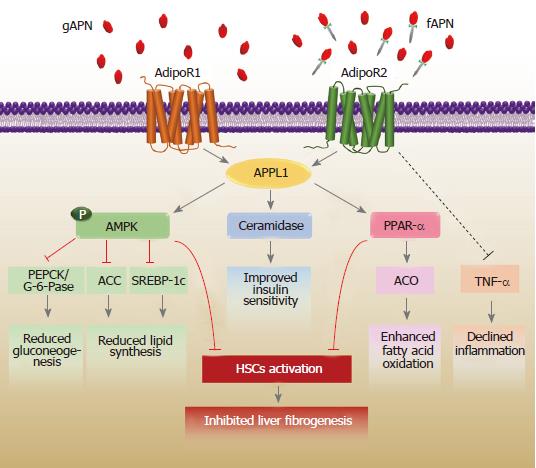Copyright
©The Author(s) 2018.
World J Hepatol. Oct 27, 2018; 10(10): 708-718
Published online Oct 27, 2018. doi: 10.4254/wjh.v10.i10.708
Published online Oct 27, 2018. doi: 10.4254/wjh.v10.i10.708
Figure 1 The biological effects of adiponectin on the liver.
Adiponectin interacts with adiponectin receptors to prompt a number of signaling pathways. AdipoR1 and R2 dependent signaling is mediated via adaptor protein phosphotyrosine interaction (APPL) 1. The signaling activates AMP-activated protein kinase (AMPK), ceramidase activity, and peroxisome proliferator-activated receptor-alpha (PPAR-α) to suppress the accumulation of lipids and regulate glucose homeostasis. The adiponectin-adipoR2 axis can reduce inflammation by inhibiting tumor necrosis factor-alpha (TNF-α) activity. Importantly, activated adiponectin also limits the activation of hepatic stellate cells (HSCs) via both AMPK and PPAR-α activation, leading to the inhibition of liver fibrogenesis. ACC: Acetyl-CoA carboxylase; ACO: Acyl-CoA oxidase; AdipoR: Adiponectin receptor; fAPN: Full-length adiponectin; gAPN: Globular adiponectin; PEPCK: Phosphoenolpyruvate carboxykinase; SREBP-1c: Sterol regulatory element binding protein-1c.
- Citation: Udomsinprasert W, Honsawek S, Poovorawan Y. Adiponectin as a novel biomarker for liver fibrosis. World J Hepatol 2018; 10(10): 708-718
- URL: https://www.wjgnet.com/1948-5182/full/v10/i10/708.htm
- DOI: https://dx.doi.org/10.4254/wjh.v10.i10.708









